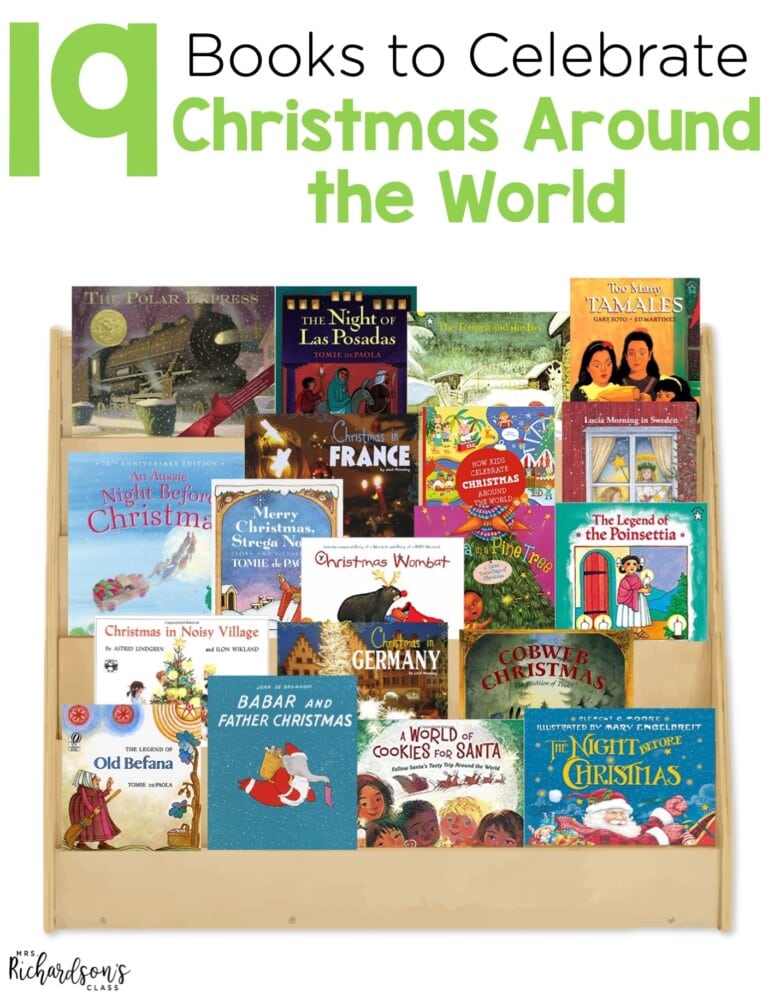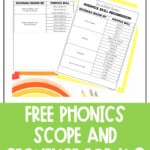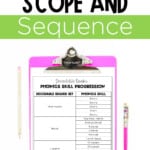

Learn all about why a phonics scope and sequence is critical to teaching and grab a free one to use in your reading small groups.
My district gave us blueprints at the beginning of each school year for each subject area. It showed us the units we would teach and what the objectives and outcomes of each unit would be. I loved looking at the blueprints to see what units we would teach that year and when. We called this a scope and sequence.
At one school I taught at, we received a scope and sequence that showed the reading skills and strategies we would teach and when. I loved teaching reading and also loved that someone else had done the hard work for me of determining when certain skills should be taught and for about how long. What we did not have was a phonics scope and sequence. This left me floundering around quite a bit. I know I’m not alone in not having a phonics scope and sequence, so let’s talk about them and why they are important on the blog today!
A phonics scope and sequence is a roadmap for you as the teacher. A scope and sequence should be based on a logical phonics skill sequence that builds from easy to hard, and it should build on previously learned skills. We first teach students the alphabet sounds and then they start noticing letters and sounds in words. They see that those letters form words. The same is true of a phonics scope and sequence. The skills build over time.
A scope and sequence also helps you know what you have taught and what you will teach next. You might bounce around and teach lots of different skills that don’t go together if you aren’t following or using a scope and sequence. It also might be hard to know how long to spend on a certain unit or know what phonics skills build on each other. A scope and sequence helps you know what order the skills should be covered and when to teach each one.
There is no right or wrong in making a phonics scope and sequence, but there are things that make sense. It should progress from easier concepts to more difficult concepts. We also know that a scope and sequence should be based on a logical sequence and build on previously learned skills.
It makes sense to teach students about short vowels before teaching them about vowel teams. Why does that make sense? Because students will encounter lots of words with short vowels in beginning texts before they encounter lots of vowel teams.
A good set of decodable readers should follow a progression, just like your phonics instruction does. After you find out your students’ strengths and weaknesses regarding phonics, you could use a decodable reader with them that addresses their area of need.
We have six different sets of decodable readers. Each kit comes with decodable books, decodable passages, scripted lesson plans, phonics skill practice, parent communication notes, and more! They follow a scope and sequence that is research-based and systematic. You can also grab the bundles to save!
If you want to take a peek at our scope and sequence, we have made a phonics scope and sequence that we have used for writing and planning our decodables.
We thought carefully about what students will encounter when reading and made sure it built on previously learned skills. If your district does not offer one, you can get ours by dropping your email below!
What other tools do you need to help set a solid foundation in phonics instruction? I’d love to hear from you in the comments and create more tools that will save you time!

Want to use the latest research to boost your readers during small groups? This FREE guide is packed with engaging ideas to help them grow!

I’m a K-1 teacher who is passionate about making lessons your students love and that are easy to implement for teachers. Helping teachers like you navigate their way through their literacy block brings me great joy. I am a lifelong learner who loves staying on top of current literacy learning and practices. Here, you’ll find the tools you need to move your K-2 students forward!


| Cookie | Duration | Description |
|---|---|---|
| cookielawinfo-checkbox-analytics | 11 months | This cookie is set by GDPR Cookie Consent plugin. The cookie is used to store the user consent for the cookies in the category "Analytics". |
| cookielawinfo-checkbox-functional | 11 months | The cookie is set by GDPR cookie consent to record the user consent for the cookies in the category "Functional". |
| cookielawinfo-checkbox-necessary | 11 months | This cookie is set by GDPR Cookie Consent plugin. The cookies is used to store the user consent for the cookies in the category "Necessary". |
| cookielawinfo-checkbox-others | 11 months | This cookie is set by GDPR Cookie Consent plugin. The cookie is used to store the user consent for the cookies in the category "Other. |
| cookielawinfo-checkbox-performance | 11 months | This cookie is set by GDPR Cookie Consent plugin. The cookie is used to store the user consent for the cookies in the category "Performance". |
| viewed_cookie_policy | 11 months | The cookie is set by the GDPR Cookie Consent plugin and is used to store whether or not user has consented to the use of cookies. It does not store any personal data. |



2 Responses
I teach in a First Grade, Dual Immersion, Spanish class. I absolutely love your resources and strategies. Do you happen to have anything that I can use in Spanish. I’m in desperate need of strategies, ideas, resources, you name it…I need it.
Thank you so much!
Hi Rosa! Ugh, I wish I had more things for you, but I don’t. I taught two-way dual language and goodness–I saw firsthand how hard my partner worked to create and find Spanish resources. It’s so, so, hard! I only have a few 1st-grade science interactive notebooks. You can find them here. https://www.teacherspayteachers.com/Product/Science-Interactive-Notebook-Part-1a-SPANISH-2061849?st=690593f261aee4c533f5dafaa4fc8430 https://www.teacherspayteachers.com/Product/Science-Interactive-Notebook-Part-1b-SPANISH-2116098?st=690593f261aee4c533f5dafaa4fc8430